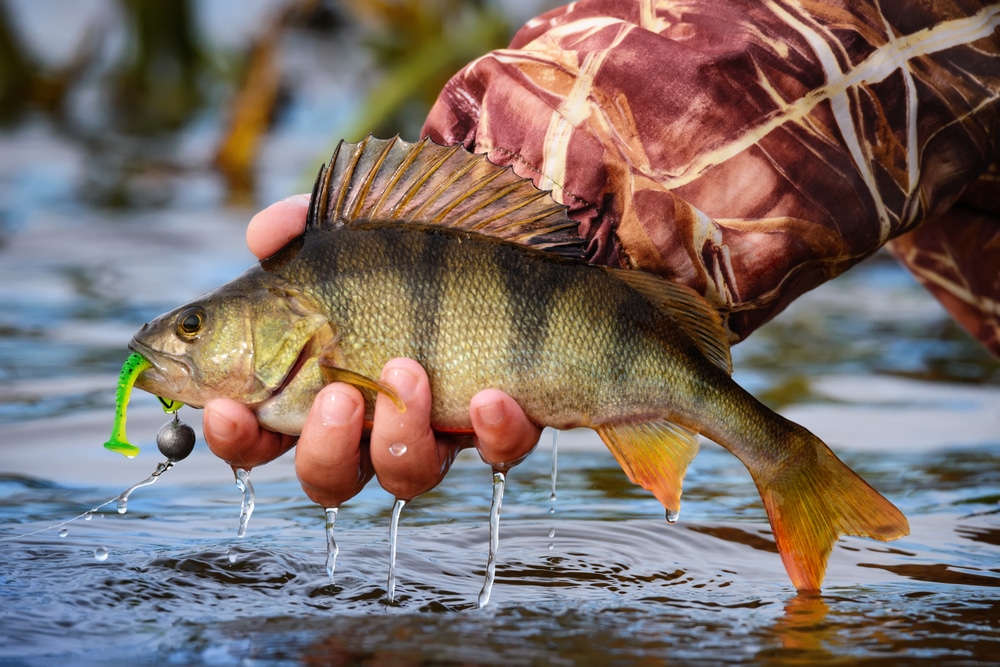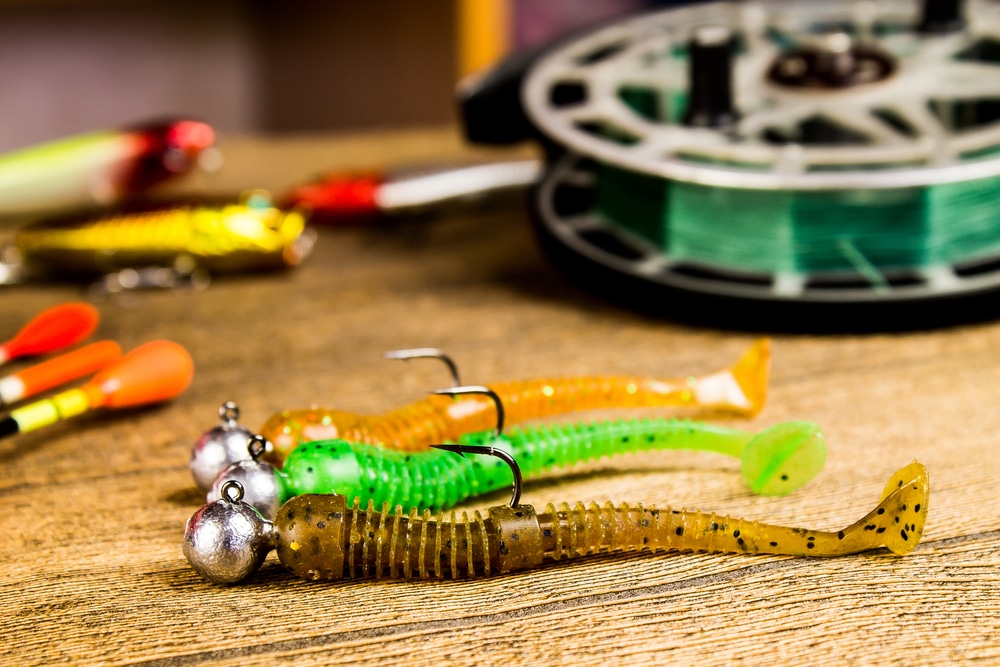“Shaky Head” is a style of jig that features a small lead ball that acts as a head for plastic baits designed for finesse fishing.
Finesse fishing uses lightweight rigging that act naturally in the water as mimics of real food items for predatory fish.
So, Shaky Head fishing is a subset of finesse fishing that uses specialized lightweight jigs with a lead head and a hook as one unit.
Some Shaky Head jigs have a screw-mount that allows you to attach the soft plastic to the lead head.
The other style has a lead head and a larger barb on the hook shank which keeps the soft plastics bait in place.
A Shaky Head jig consists of the lead head with a metal brad that protrudes from the lead ball.

Also coming from the lead ball is a metal hook.
You thread your soft plastic onto the brad and then insert the hook.
The effect is that the lead ball makes the head of the bait mimic you are using, and the hook secures the soft plastic in place.
On the lead head is a small loop that allows you to attach your fishing line.
Shaky Head fishing is the presentation soft plastic jigs realistically to fish that may not strike lures or take bait.
Many fish, especially in areas where they are over fished will learn that popular lure or baits mean danger and will avoid them.
When that situation happens or when fish are not striking lures, many anglers switch to finesse fishing and a top choice for baits are Shaky Head jigs.
Contents
How To Fish A Shaky Head
A shaky head jig is basically a bottom bouncer – you bounce the jig along the bottom or through weeds.
Generally, you can fish Shaky Head jigs all year long and especially in situations where there is a lot of fishing pressure on a body of water.
There are a variety of Shaky Head hook/head options, and some are colored to match your soft plastic baits.
The ideal setup is a 20 pound test braid that is highly visible – sold as High Vis – paired with a 5-15 foot leader either in mono or fluorocarbon.
The High Visible line is critical to Shaky Head fishing since it allows you to see what your line is doing even when you cannot see the Shaky Head jig.
When you fish a longer leader – 10-15 feet – you are giving yourself the option of cutting the leader down as you fish.
Many times, Shaky Head fishing occurs around objects that can damage your leader, especially if you are using Fluorocarbon for your leader.
You want to cut the jig and retie it to the leader anytime there is damage to the line or when you catch a fish.

As far as rod selection goes a medium heavy power with a fast action tip one would suffice.
You can also choose a heavy power rod with a fast action tip.
Line is braided High Vis at 20 pound test and a long leader – 5-10 feet – in 8-12 pound test.
The reason for the heavier line is that Shaky Head fishing is often in deep cover or shallow weeds.
You want the extra strength and durability of the line so that you can yard your jig through these heavy obstacles without the line snapping.
Jig Head sizes are small and most appropriately a 1/8 ounce jig is a good bet.
When you are targeting bigger fish, you may want to bump up to a bigger hook/jig size.
Heavier jigs give you a touch more accuracy when you cast. If you are casting into a narrow zone, you want a heavier jig.
Otherwise, the lighter jigs will help you present a better mimic as you fish sensitive fish.
The action is a simple cast out to a structure, allow the jig to hit the bottom and then jig is delicately as you retrieve it.
Cast again and work the area. Shaky Head jigs and fishing are ideal when other lures or baits are not working for you.
What Are Shaky Head Jigs Used For?
Shaky Head jigs are part of the finesse family of fishing options and a tactic that many anglers use when traditional lures, live baits, and baited hooks are not working to induce strikes.
In many cases, where fishing often occurs, fish become bait shy.
Take a lake that is heavily fished.
The fish here are accustomed to seeing many of the top lures because that is what anglers use.
When those lures no longer hold their power over the fish, the fish stop biting.
When that happens, you switch your tactics to a finesse style of bait, and the Shaky Head jig is a first choice for many anglers.
How Do You Use a Shaky Head Rig?
A Shaky Head rig is a single piece that includes the bait and weight.
As you assemble your Shaky Head jig, you tie the entire unit to your leader.
Once it is attached to the line, you toss it out where you want it to be – generally, that means around a cover or structure – and then allow the weight to settle to the bottom.
You jig the Shaky Head gently as you retrieve the line.
Continue to cast and retrieve as needed.
A Shaky Head jig or rig is an alternative option for attracting fish when traditional lures or baits are not working to cause predatory fish to strike your line.
If you fish on waters that have a higher fishing pressure – a lot of anglers fishing many months of the year – you want to familiarize yourself with Shaky Head jigs.
What Do You Throw A Shaky Head in?
Different patterns that work well with Shaky Head jigs include soft plastic worms and minnow patterns along with stickworms and creature baits.
Small frogs, lizards and other options work well with Shaky Head patterns.
Even though you are using soft plastic baits, even Jerkbaits can work, you want to borrow a lesson from fly-fishing.
Matching the hatch is an ideal with way to elevate the effectiveness of Shaky Head jigging.
When you match the hatch you are matching your baits to the natural selection of seasonal creatures.
In the case of fly-fishing, they are matching the fly pattern to insects that are present so that the fish will recognize a known food source.
Doing so with Shaky Head jibs gives you an even brighter target and tool to lure sensitive fish out of their holes and onto you hook.







